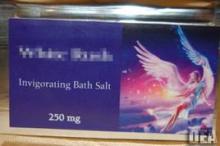Designer stimulants are among the latest compounds to make the country’s Schedule 1 list of illegal drugs.
On July 9, President Obama signed into law the Synthetic Drug Abuse Prevention Act of 2012. The law adds 31 compounds to schedule I, including 9 that fall into the cathinone-based "bath salts" category and 20 found in synthetic marijuana, commonly called spice or K2.
Sen. Amy Klobuchar (D-Minn.), who sponsored one of three bills contained in the law, applauded the president’s action.
"In Minnesota and across the country, we are seeing more and more tragedies where synthetic drugs are taking lives and tearing apart families," she said in a statement. "[The president’s] action means that this critical legislation to give law enforcement the tools they need to crack down on synthetic drugs is finally the law of the land."
The legislation bolsters existing laws in 44 states, which have previously outlawed specific compounds related to cathinone. However, underground chemists constantly alter the molecular makeup of the compounds, creating versions that are not covered in these laws and are therefore technically legal. The new act bans all drugs in the class now known as substituted cathinone enhancements.
The drugs are both powerful and dangerous, according to the American Association of Poison Control Centers. In 2010, poison control centers around the country began getting calls about reactions – some extreme – to unknown substances.
That year, "poison centers nationwide responded to about 3,200 calls related to synthetic marijuana and bath salts. In 2011, that number jumped to more than 13,000 calls. Sixty percent of the cases involved patients 25 and younger," Dr. Rick Dart, the association’s president, said in a statement.
Tachycardia, agitation, hallucinations, extreme paranoia, delusions, and elevations in blood pressure are common symptoms of exposure. Up to 40% of users can experience severe seizures. Psychosis occurs in 14%-40%. While in a psychotic state, some users exhibit dangerously bizarre behaviors.
Sensationalistic reports of cannibalism and users ripping off their clothing in fits of paranoia have hit national news recently, but the relationship to bath salts is often unclear, according to a report by Dr. Jason Jerry.
"There are simply no data regarding the prevalence of psychotic symptoms in the larger group of all synthetic stimulant users," he said.
Patients who arrive at the emergency department with such severe symptoms are often incorrectly given psychiatric diagnoses, said Dr. Jerry of the Cleveland Clinic. Now, reactions to the compounds should be among the first items in a differential diagnosis for these patients.
"Most patients ... will present with anxiety, agitation, and psychosis," he wrote (Cleve. Clin. J. Med. 2012;79:258-64). "Rather than assume that they are psychiatric patients, one should consider the possibility of [bath salts intoxication] and pay close attention to the possible medical sequelae associated with SLID [synthetic legal intoxicating drug] use, such as elevated blood pressure, tachycardia, and seizure."
Because the drugs have only recently been seen in the United States, toxicology screens are also relatively new. Several companies now offer such screens; almost all of them require that urine samples be sent for outside lab processing.
Most use mass spectroscopy to identity cathinone-related compounds. An enzyme-linked immunosorbent assay (ELISA) test has recently become available for in-house use.
A new mass spectroscopy test by Ameritox became available in July; the test can identify three cathinone compounds and five other chemicals often found in bath salts. But drug testing is just one step in getting a grip on the rising problem of synthetic stimulant use, Dr. Harry Leider, chief medical office of Ameritox, said in an interview.
"The solution to this problem is not simple. It involves multiple forces coming together."
Law enforcement and the medical community need to be on the "fast track, to determine if the drugs are in a community," he said.
"People need to be educated about the idea that something isn’t safe just because it’s legal. Doctors need to become more knowledgeable about the drugs and their effects. And we need support from payers so everyone can keep pace with the chemists, who keep turning out new compounds to keep ahead of the laws."


